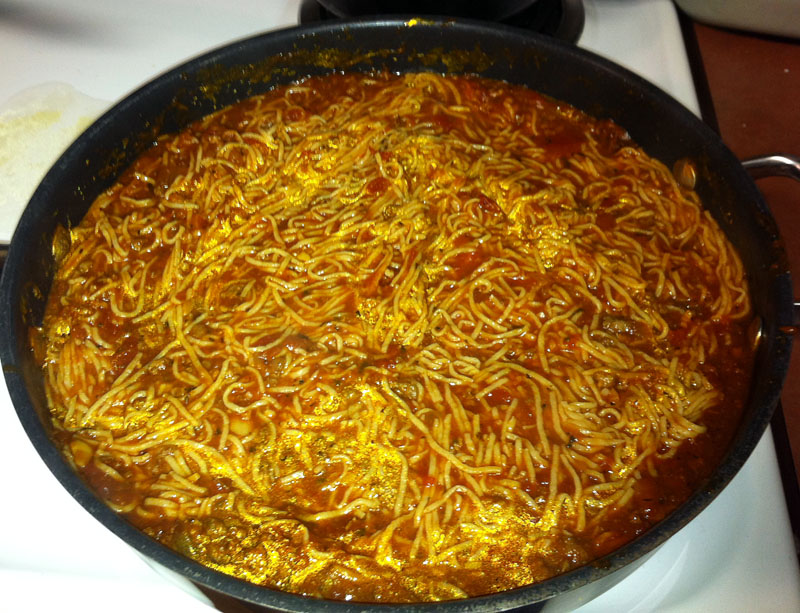I finally got a new pasta maker to replace the one I destroyed via water and overestimating my ability to remember how to reassemble it. :) This time, I went with a motor! I stuck with an Atlas 150, which was a great machine for me until I went all Mr. Fixit on it.
Previously, I'd been using store-bought flour. Last night was my first try with it using flour I milled myself, though I hedged my bets on this one with around 33% King Arthur Bread Flour. I didn't find a lot on milling pasta flour using the search, so hopefully my experiments will aid searchers somewhere down the line.
Attempt #1
I didn't think to take pics of anything but the final product, I'll do better on the next run, promise. All grains are from Pleasant Hill.
I started out with 6 oz of durum wheat (14%) and 2 oz of hard white wheat, milled fine, mixed with 3 oz KA. By the time it was all said and done, I easily added another 1-2 oz of KA.
Put the milled flour in a bowl, make a well, crack two room-temperature eggs in it, add a couple of healthy pinches of kosher salt (1.5 t maybe?). Whisk with a fork to blend in flour from the edges. When it gets too dry, pour in a little bit of room temperature water (I ended up using just over 3/4 cup of water). Eventually it becomes too heavy to stir with a fork, switch to a spatula or spoon or whatever you use. I chose to hand knead this instead of using my DLX, so I have some sense memory of the dough development as experiments progress.
After it comes together in the bowl, move to a heavily-floured surface and knead for 8-10 minutes. Mine was really, really soft and damp, and I used a lot of KA flour by the time the kneading was done. It still felt really soft, almost like focaccia. Put the dough into an oiled bowl and cover with plastic wrap. I let it sit 45 minutes.
I rolled it out about 3/4" thick (using a lot more flour), cut off a chunk about the area of slice of cheese, and started running it through the Atlas. Lemme just say right now, if you're thinking of buying one of these, get one with a motor. It's so nice to be able to work solo, and it takes less than 3 seconds to move the motor from the flattening rollers to the cutter and back. I folded it back on itself a couple of times at setting 0 and setting 1, then progressed until setting 4, their recommended thickness for the spaghetti cutter.
Moved the motor to the cutter, and ran the first sheet through. It was a gummy, messy disaster. Fortunately, it was going to be discarded anyway (as per the recommendations for first-time use).
Clean up, consult the manual. If it fails to cut, add flour to the dough and run it through the rollers.
I liberally sprinkled the cutting board, cut off another square of dough, floured both sides, and ran it through at 0. Folded, floured, repeated. Move to 1, same thing. As it got thinner, I sprinkled flour on the sheet of dough and gently massaged it over the surface, then flipped and hit the other side. Finally, I sprinkled some flour directly on the cutting rollers.
I should talk here about the texture of the dough. I didn't do any sifting, so all the bran was still in the dough, which felt kind of grainy. When at the final thickness, I could feel the bran in relief when spreading on the KA flour. This was the first thing that concerned me.
Back to the rollers -- this time, everything came through the cutter mostly intact, but the individual strands of noodles were, in some cases, still clinging to each other, looking vaguely like a computer ribbon cable. This was the second thing that concerned me.
I hung the noodles on the drying rack, and the bran in the tiny noodles made them feel almost like they'd been rolled in sand. This was the third thing that concerned me.
At this point, my wife is on the way home from work. I have a bunch of noodles that I'm pretty sure are going to be a gummy, grainy mess. Oh well, I've got dried pasta in the pantry, I can always break it out if necessary.
The noodles hang out and dry for around 45 minutes. Now, they feel like dry, sandy ribbons. I'm not optimistic.
I throw the noodles in 6 quarts of boiling salt water to which I've added 1 T of olive oil, and boiled them for 4 minutes, stirring every 30 seconds or so to keep them from clumping up, then drained them in a collander before adding them to the sauce for about 90 seconds on the stove.
Fearing the worst, I added some fresh-ground asiago and parmesan and tried some.
They were fantastic.
Nothing stuck together, and there was no grainy-ness. It was amazingly tender.
Heartened by the success, I'm going to try using more fresh milled flour next time, perhaps only using the KA for adjustments (which would still end up being a couple of ounces if it runs to form).
